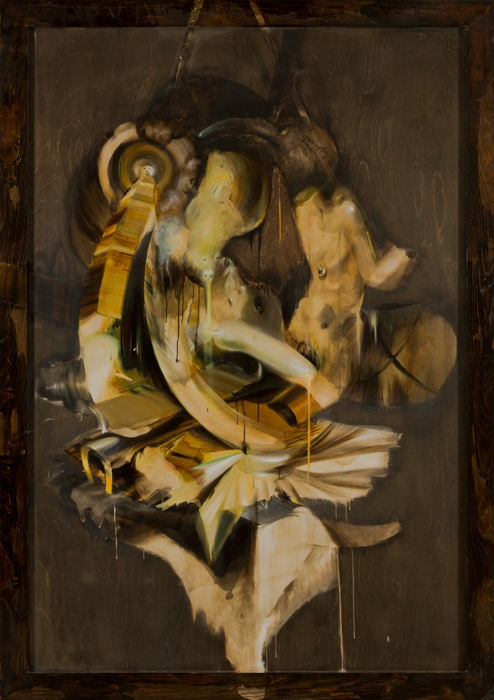Vicky Wright is a kind of alchemist. Alchemy isn’t real, of course. Neither is witchcraft, the occult or magic. Yet in her paintings Wright manages to invoke a sense of the esoteric and the irrational, not because she has a true belief in them (she’s too reasonable for that), but because they serve as ways to open painting up to different critical dimensions and affective registers, allow the act of painting to speculate on its own potential lack of proper limits, in the face of critical fashions that continuously delimit what’s supposed to be relevant and what’s not. Zombie abstraction? Wright’s painting happily absorbs those corpses and skewers them with electrodes to make them dance. Post-Internet virtuality? Wright’s painting laughs and declares, ‘Long live the New Flesh.’
The strange work of Wright’s paintings lies somewhere between figuration and sheer painterly self-reference. A lush, layered, smeared, dribbling accumulation of marks assembles, where none sits innocently on the surface – wide, striated brushloads of paint angle and veer in ways that begin to carve and sculpt themselves into bizarre planes and volumes, lifting away from the wood grain of the panels on which Wright always paints.
Psychedelic, phantasmagoric, these abstractions have a grotesque, gothic energy, which harks back to Dürer and Bosch, but resist their visual resolution by remaining in a state of in-between unnameability
But the counterintuitive alchemy Wright performs is to make abstract painterly marks that shift, without one quite realising it, into the appearance of literal objects that have no referent in the real world. Perception’s tendency to project form into the formless plays weird tricks. Marks become the pages of books, or the beaks of birds, or dismembered torsos. Flecks of white glinting in little whorls of blackness conjure the apprehension of tiny eyes, speckled among the queasy spectacle of paint warping itself into something vaguely horrible and animated. Detail is carefully suggested in Wright’s paintings, but dissolves as you get close. Psychedelic, phantasmagoric, these abstractions have a grotesque, gothic energy, which harks back to Dürer and Bosch, but resist their visual resolution by remaining in a state of in-between unnameability, with more than a nod to the edge-of-cognition paranoia of H.P. Lovecraft.
In her most recent works Wright takes on the (father) figures of modernist abstraction, bringing fiercely vivid strips and spots of primary colours into her paintings’ more typically tertiary gloom, simultaneously warring with and articulating the chaos of marks around them. If Wright is a big fan of the antirational philosophy of the likes of Gilles Deleuze and Jean-François Lyotard, she seems equally fascinated, in these latest paintings, by the quasi-mysticism that often underpinned the geometric abstraction of painters such as Malevich and Mondrian; geometry has always been central to magic, after all. Winding through these entanglements is a play on gender and irrationality, through an attention to form and formlessness. It’s not by accident that Wright cites the early feminist Charlotte Perkins Gilman’s account of her postpartum psychosis, The Yellow Wallpaper (1892). If witchcraft and hysteria were once the negative (feminine) opposites of the more masculine virtues of religious revelation or artistic genius, these tropes are appropriated by Wright to complicate our understanding of painting’s role as a site of mastery, self-dissolution and desire.
In the face of the dissolution of painting into art-historical lounge-decoration or postdigital academic morbidity, Wright demonstrates that what painting is, and what it can achieve, is determined by the scope of the thinking you bring to it, and the unknown figures you release in the process.
Bolton-born, and now London-based, Vicky Wright explores the artworld’s underside – quite literally painting on reversed panels. Touching on structures of control, subjugation and fantasy, her layered, muddied figuration teases with aesthetic grabs from the medieval to contemporary gaming culture. Successive series have been shown in three solo outings since 2010 at the Josh Lilley gallery, London. Selected by J.J. Charlesworth, associate editor, ArtReview.
Read all of our 2015 FutureGreats profiles
This article was first published in the March 2015 issue.
